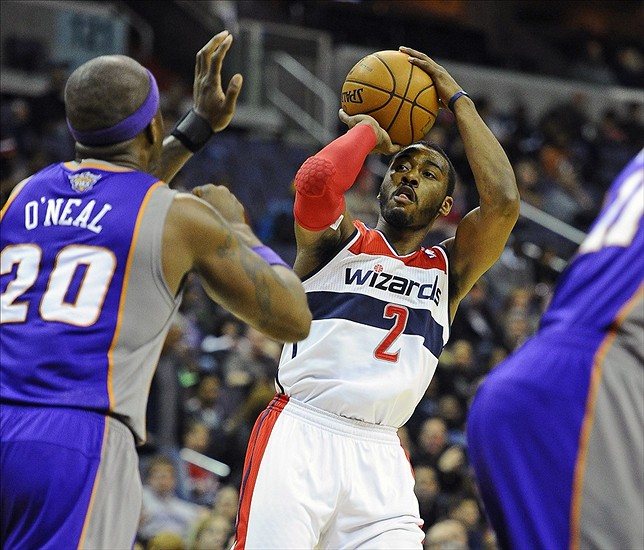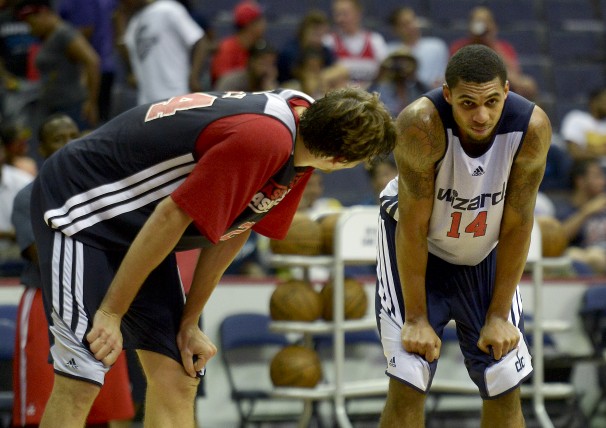
Writing at Grantland, Kirk Goldsberry introduced a new metric he dubbed “ShotScore.” Basically, the idea is to compare a player’s shooting from various locations on the floor to the league average from that spot. Effectively, it adds a degree of difficulty component to NBA shooting stats.
I could do without his strawman stuff about field goal percentage — the problems with FG% are why stat goobers switched to effective field goal percentage, which accounts for the effect of the 3pt shot — but Goldsberry’s work is both good and flawed. Want a more in-depth look at what’s wrong with it, check out Tom Ziller’s piece. To summarize: ShotScore is way complex, and it rewards players for shooting better than average from anywhere on the floor — even if it’s just a low-percentage shot, period. Also, it doesn’t account for a valuable way players produce points: shooting free throws.
Let me illustrate. Let’s say that the league average on long two-point attempts is 40%. If a player came along and shot nothing but long twos (and lots of them), and shot 45%, ShotScore would say that player was a good shooter — +100 points compared to the league average taking those same shots.
Except, that player would actually be taking a low value shot. The league’s eFG (which accounts for the 3pt shot) was .496 last season, which means that given 1,000 FGA, we’d expect the league to produce (on average) 992 points — 92 more than the “good” shooter.
To further illustrate, let’s say Mr. Long Two has a teammate who by some weird design shoots only three-pointers (and lots of them), but shoots just league average. Archaic FG% would say Long Two is the better shooter, .450 to .359. ShotScore would agree. Long Two produced 100 points more than the league average shooter would have produced on the same number of long two-point attempts.
Both would be wrong. Because that average three-point shooter would have produced 992 points on his 1,000 FGA — 92 points more than the “better” shooter taking long two-point attempts. Any coach with a bit of sense would want an average 3pt shooter over a “better than average” shooter on long twos.
In his article, Ziller introduces some simpler metrics that actually do a better job of determining which players shoot the best. His “simpler” approach uses a bit of logic and stats that are already publicly available. I’m not going to waste time explaining — if you’re interested in the details, click over to Ziller’s article.
Using my spreadsheets, I pointed Ziller’s formulas at the Wizards last season. And, it’s not a pretty sight. Using Ziller’s “Extra Field Points” metric, only three Wizards last season were a net positive: Martell Webster, Trevor Ariza and Jan Vesely.
Now, before you throw out the stat because of Vesely, keep in mind that he had an efg of .500 last season — league average was .496. Given Vesely’s number of shot attempts, the league would have scored 113 points — Vesely generated 114 points off his field goal attempts, a net of +1.
Here’s a quick table from last season:
| PLAYER |
Extra Field Points |
| Martell Webster |
70 |
| Trevor Ariza |
4 |
| Jan Vesely |
1 |
| Cartier Martin |
0 |
| Trevor Booker |
-2 |
| Shelvin Mack |
-4 |
| Jason Collins |
-4 |
| Earl Barron |
-11 |
| Jannero Pargo |
-13 |
| Shaun Livingston |
-18 |
| A.J. Price |
-18 |
| Nene Hilario |
-20 |
| Garrett Temple |
-20 |
| Jordan Crawford |
-23 |
| Emeka Okafor |
-26 |
| Bradley Beal |
-27 |
| Chris Singleton |
-48 |
| Kevin Seraphin |
-51 |
| John Wall |
-70 |
This table tells us why the Wizards lost so many games last season. Given the same number of field goal attempts, the league would have produced 6,645 points from the field. The Wizards produced 6,365 — a deficit of 280 points. The team’s overall scoring deficit last season: 208. At the bottom of the list is a stark reminder of what John Wall’s poor shooting AND poor shot selection costs the team.
Washington was better from the free throw line, but still below the league standard. For the season, the team’s free throw shooting cost them 36 points. That works out to about 0.4 points per game — one extra loss over an 82-game schedule.
Here’s a look at the team’s free throw shooting:
| PLAYER |
Extra FT Points |
| Martell Webster |
19 |
| John Wall |
16 |
| Jordan Crawford |
7 |
| Trevor Ariza |
6 |
| Bradley Beal |
5 |
| Shaun Livingston |
4 |
| A.J. Price |
2 |
| Jason Collins |
0 |
| Jannero Pargo |
0 |
| Shelvin Mack |
-1 |
| Cartier Martin |
-1 |
| Earl Barron |
-2 |
| Garrett Temple |
-2 |
| Kevin Seraphin |
-5 |
| Nene Hilario |
-7 |
| Chris Singleton |
-13 |
| Trevor Booker |
-14 |
| Jan Vesely |
-17 |
| Emeka Okafor |
-35 |
This table shows Wall regaining some ground from the FT line that he gives up with his bad shooting from the floor. Some, but not all.
One last table looking strictly at shooting — this one combining extra field goal points (EFPT) with extra free throw points (EFTP) into a unified Extra Points (EPTS). Hmm, I guess if we’re talking Wizards, it could “in-EPTS” couldn’t it?
| PLAYER |
EFGP |
EFTP |
EPTS |
| Martell Webster |
70 |
19 |
88 |
| Trevor Ariza |
4 |
6 |
11 |
| Cartier Martin |
0 |
-1 |
-1 |
| Jason Collins |
-4 |
0 |
-3 |
| Shelvin Mack |
-4 |
-1 |
-4 |
| Jannero Pargo |
-13 |
0 |
-12 |
| Earl Barron |
-11 |
-2 |
-12 |
| Shaun Livingston |
-18 |
4 |
-14 |
| A.J. Price |
-18 |
2 |
-16 |
| Jordan Crawford |
-23 |
7 |
-16 |
| Jan Vesely |
1 |
-17 |
-17 |
| Trevor Booker |
-2 |
-14 |
-17 |
| Bradley Beal |
-27 |
5 |
-22 |
| Garrett Temple |
-20 |
-2 |
-22 |
| Nene Hilario |
-20 |
-7 |
-26 |
| John Wall |
-70 |
16 |
-54 |
| Kevin Seraphin |
-51 |
-5 |
-56 |
| Emeka Okafor |
-26 |
-35 |
-61 |
| Chris Singleton |
-48 |
-13 |
-61 |
The numbers may not add exactly because of rounding, but it’s good enough for my purposes today. Note that only two players were net positives when they shot the ball: Webster and Ariza — both of whom shot less than their inaccurate teammates.
Wall, for example, led the team in per minute true shooting attempts, but was the team’s fourth worst shooter overall. Seraphin was third in usage (behind Wall and Jordan Crawford), and third worst shooting the ball. The team needs to either redistribute its shot attempts or get significant improvement from the guys pulling the trigger.
So, while all this is good, it’s still focused only on shooting. Players contribute in other ways offensively that show up in the box score — getting offensive boards, assisting, avoiding turnovers.
Using Ziller’s principle and my own revised version of Dean Oliver’s individual offensive rating formula (expressed as points produced per 100 individual possessions), I calculated an expected points produced based on the number of possessions a player used. So, finding Additional Points Produced (APTS) is EPP – PROD (that’s expected points produced minus points produced).
Let’s take Webster as our example. Last year, through FGA, FTA, turnovers, offensive rebounds and assists, Webster used 681 possessions. The league’s offensive rating was 105.8 points per 100 possessions, so the “expected points produced” for those 681 possessions was 721. Webster produced 797, meaning that (with rounding) Webster produced 77 Additional Points.
Note: points produced is NOT the same thing as points scored. Points produced includes non-scoring contributions to the offense (offensive rebounds, assists, turnovers) and shares credit with teammates.
| PLAYER |
APTS |
| Martell Webster |
77 |
| Trevor Booker |
11 |
| A.J. Price |
1 |
| John Wall |
0 |
| Jason Collins |
-3 |
| Shelvin Mack |
-4 |
| Shaun Livingston |
-11 |
| Jannero Pargo |
-13 |
| Earl Barron |
-14 |
| Jan Vesely |
-14 |
| Trevor Ariza |
-14 |
| Nene Hilario |
-17 |
| Cartier Martin |
-25 |
| Bradley Beal |
-28 |
| Garrett Temple |
-30 |
| Jordan Crawford |
-36 |
| Emeka Okafor |
-39 |
| Chris Singleton |
-54 |
| Kevin Seraphin |
-127 |
Unsurprisingly, Webster is still at the top. He shot the ball extremely well last season and committed few turnovers. But check out number four on the list — Wall. It’s a net zero, which means that the PG produced an average number of points given the possessions he used. What impresses me, however, is the value of his non-shooting contributions. Remember, Wall’s shooting from the floor was a net -70 points. His overall shooting (free throws and field goals combined) was a net -54. Even so, his overall impact was average. If he ever really learns how to shoot…
At the bottom of the list we see the heavy cost of Kevin Seraphin’s terrible shooting, few offensive boards, no assists, and abundant turnovers. Chris Singleton’s -54 is bizarrely impressive given the forward’s low usage and fairly low minutes.
Assuming they’re able to maintain the defense, the team must get better on offense to reach the playoffs. Some of that is possible (likely even) by individual improvement. Bradley Beal had a rough start to his rookie year, but was significantly more efficient as the season wore on. And he’s looked good in preseason.
Nene has long been one of the league’s more efficient offensive players, but hampered by injuries, he had his least efficient full season since he was a rookie — in 2002-03. Will Nene be able to get back to his career norms (offensive rating of about 112 vs. 103 last season), or was last year a sign of the inevitable age-related decline?
No matter how they do it, the Wizards must get better on offense if they hope to make the playoffs — especially with the possibility of an extended absence from defensive stalwart Emeka Okafor.











